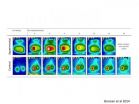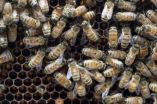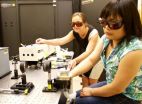(Press-News.org) MEDFORD/SOMERVILLE, Mass. – Honey bees, especially the young, are highly sensitive to temperature and to protect developing bees, adults work together to maintain temperatures within a narrow range. Recently published research led by Philip T. Starks, a biologist at Tufts University's School of Arts and Sciences, is the first to show that worker bees dissipate excess heat within a hive in process similar to how humans and other mammals cool themselves through their blood vessels and skin.
"This study shows how workers effectively dissipate the heat absorbed via heat-shielding, a mechanism used to thwart localized heat stressors," says Starks. The research is published in the June 10 edition of the journal Naturwissenschaften, which appeared online April 24.
This discovery also supports the theoretical construct of the bee hive as a superorganism—an entity in which its many members carry out specialized and vital functions to keep the whole functioning as a unit.
Young bees develop within wax cells. For healthy development, the youngsters must be maintained between 32degrees Celsius, or 89.6 degrees Fahrenheit, and 35 degrees Celsius, or 95 degrees Fahrenheit. In contrast, adults can withstand temperatures as high as 50 degrees Celsius, or 122 degrees Fahrenheit
Previous research has shown that workers bees, among other duties, control the thermostat essential to the hive's survival.
When temperatures dip, worker bees create heat by contracting their thoracic muscles, similar to shivering in mammals. To protect the vulnerable brood when it's hot, workers fan the comb, spread fluid to induce evaporative cooling, or – when the heat stress is localized - absorb heat by pressing themselves against the brood nest wall (a behavior known as heat-shielding).
But until the Tufts study, scientists did not know how the bees got rid of the heat after they had absorbed it.
Starks' team included doctoral student Rachael E. Bonoan, former undergraduate student Rhyan R. Goldman, and Peter Y. Wong, a research associate professor in the department of mechanical engineering in the School of Engineering at Tufts. Bonoan and Goldman collected data on seven active honeybee hives that were framed by clear Plexiglas walls.
Each colony numbered 1,000 to 2,500 adult bees. An eighth hive, empty of bees, was used as a control. Using a theater light, the researchers raised the internal temperature of all eight hives for 15 minutes. Temperature probes recorded internal temperature throughout the heating portion of the experiment.
As anticipated, the worker bees pressed their bodies against the heated surfaces near the brood. Like insect sponges, they absorbed the heat, which lowered temperatures. After 15 minutes, a time brief enough to prevent serious harm to the bees, the theater light was turned off.
Immediately following, heat movement within the hive and external hive temperatures were tracked via thermal imaging. Within 10 minutes of cooling, temperatures in the active hives were down to safe levels. Meanwhile, the control hive remained at 40 degrees Celsius. "Since the control hive did not have bees, the differences in temperature were likely caused by worker behavior," Starks says.
Using thermal imaging, the scientists observed that temperatures increased peripheral to the heated regions of the hive as the brood nest began to cool. The thermal images clearly showed that the bees had physically moved the absorbed heat in their bodies to previously cooler areas of the hive. "Moving heat from hot to cool areas is reminiscent of the bioheat transfer via the cardiovascular system of mammals," says Starks.
INFORMATION:
This research was supported by the Tufts University Biology Department and the Tufts University National Science Foundation Research Experience for Undergraduates Program (DBI 263030).
Bonoan RE, Goldman RR, Wong PY and Starks PT. 2014. Vasculature of the Hive: heat dissipation in the honey bee (Apis mellifera) hive. Naturwissenschaften. 101: 459-465
Tufts University, located on three Massachusetts campuses in Boston, Medford/Somerville, and Grafton, and in Talloires, France, is recognized among the premier research universities in the United States. Tufts enjoys a global reputation for academic excellence and for the preparation of students as leaders in a wide range of professions. A growing number of innovative teaching and research initiatives span all Tufts campuses, and collaboration among the faculty and students in the undergraduate, graduate, and professional programs across the university's schools is widely encouraged.
How honey bees stay cool
2014-07-23
ELSE PRESS RELEASES FROM THIS DATE:
Hormones after breast cancer: Not fuel for the fire after all?
2014-07-23
A new study supports a growing body of research suggesting a safe and effective role for natural steroid hormones in treating postmenopausal breast cancer, with fewer detrimental side effects and improved health profile than with standard anti-hormone therapies. The study will be published in final format today in the open-access journal Reproductive Biology and Endocrinology.
Breast cancer is the most frequently diagnosed cancer in women in the United States. Approximately 70% of breast cancers are diagnosed in postmenopausal women. Major clinical trials and experimental ...
'Big picture' thinking doesn't always lead people to indulge less, study says
2014-07-23
CHAMPAIGN, Ill. — Buy the latest electronic gizmo du jour, or use that money to fix a leaky roof? Go out with friends, or stay home to catch-up on work to meet that looming deadline? And after you've finished that big project, do you treat yourself to a slice of chocolate cake or settle for a piece of fruit?
These are the kind of self-control dilemmas that people face all the time. And according to research from a University of Illinois expert in new product development and marketing, self-focus plays an important role in how consumers make decisions.
When prompted ...
Urban heat boosts some pest populations 200-fold, killing red maples
2014-07-23
New research from North Carolina State University shows that urban "heat islands" are slowly killing red maples in the southeastern United States. One factor is that researchers have found warmer temperatures increase the number of young produced by the gloomy scale insect – a significant tree pest – by 300 percent, which in turn leads to 200 times more adult gloomy scales on urban trees.
"We'd been seeing higher numbers of plant-eating insects like the gloomy scale in cities, and now we know why," says Adam Dale, a Ph.D. student at NC State and lead author of two papers ...
NASA sees Typhoon Matmo making second landfall in China
2014-07-23
NASA's Terra satellite passed over Typhoon Matmo when it was moving through the Taiwan Strait for its final landfall in mainland China.
On July 23 at 02:45 UTC (July 22 at 10:45 p.m. EDT), the Moderate Resolution Imaging Spectroradiometer or MODIS instrument aboard NASA's Terra satellite captured a picture of Typhoon Matmo after its center crossed the northern part of the island nation of Taiwan and entered the Taiwan Strait. The Taiwan Strait is the body of water between western Taiwan and southeastern China. The MODIS image showed a cloud-covered center of circulation, ...
Targeting the brain to treat obesity
2014-07-23
Unlocking the secrets to better treating the pernicious disorders of obesity and dementia reside in the brain, according to a paper from American University's Center for Behavioral Neuroscience. In the paper, researchers make the case for treating obesity with therapies aimed at areas of the brain responsible for memory and learning. Furthermore, treatments that focus on the hippocampus could play a role in reducing certain dementias.
"In the struggle to treat these diseases, therapies and preventive measures often fall short. This is a new way for providers who treat ...
UNC researchers find unsuspected characteristics of new CF drugs, offering potential paths to more effective therapies
2014-07-23
In lab experiments using tissue samples cultured from cystic fibrosis patients, scientists at the UNC School of Medicine and the UNC Marsico Lung Institute have shown that a new CF drug counteracts the intended beneficial molecular effect of another CF drug.
The finding, published today in the journal Science Translational Medicine, shows how a mutant CFTR protein becomes unstable and loses its ability to function properly when in the presence of the two drugs. The research offers several insights into how novel CF pharmacotherapies could be improved.
“In our human ...
Spinach could lead to alternative energy more powerful than Popeye
2014-07-23
WEST LAFAYETTE, Ind. — Spinach gave Popeye super strength, but it also holds the promise of a different power for a group of scientists: the ability to convert sunlight into a clean, efficient alternative fuel.
Purdue University physicists are part of an international group using spinach to study the proteins involved in photosynthesis, the process by which plants convert the sun's energy into carbohydrates used to power cellular processes.
"The proteins we study are part of the most efficient system ever built, capable of converting the energy from the sun into chemical ...
The birth of topological spintronics
2014-07-23
The discovery of a new material combination that could lead to a more efficient approach to computer memory and logic will be described in the journal Nature on July 24, 2014. The research, led by Penn State University and Cornell University physicists, studies "spin torque" in devices that combine a standard magnetic material with a novel material known as a "topological insulator." The team's results show that such a scheme can be 10 times more efficient for controlling magnetic memory or logic than any other combination of materials measured to date.
"This is a really ...
Strategy proposed for preventing diseases of aging
2014-07-23
AUDIO:
Some researchers are proposing that changing how medical care is delivered could help prevent multiple chronic diseases and extend healthy lifespan. The idea, they argue, would be to target the...
Click here for more information.
Medicine focuses almost entirely on fighting chronic diseases in a piecemeal fashion as symptoms develop. Instead, more efforts should be directed to promoting interventions that have the potential to prevent multiple chronic diseases and extend ...
Sleep deprivation may increase susceptibility to false memories
2014-07-23
Not getting enough sleep may increase the likelihood of forming false memories, according to research published in Psychological Science, a journal of the Association for Psychological Science.
In a study conducted by psychological scientist Steven J. Frenda of the University of California, Irvine and colleagues, sleep-deprived people who viewed photographs of a crime being committed and then read false information about the photos were more likely to report remembering the false details in the photos than were those who got a full night's sleep.
Research has demonstrated ...







